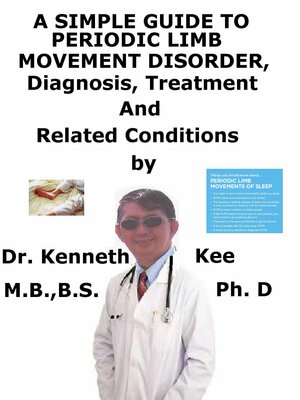A Simple Guide to Periodic Limb Movement Disorder, Diagnosis, Treatment and Related Conditions
ebook
By Kenneth Kee

Sign up to save your library
With an OverDrive account, you can save your favorite libraries for at-a-glance information about availability. Find out more about OverDrive accounts.
Find this title in Libby, the library reading app by OverDrive.



Search for a digital library with this title
Title found at these libraries:
| Library Name | Distance |
|---|---|
| Loading... |
This book describes Periodic Limb Movement Disorder, Diagnosis and Treatment and Related Diseases
Periodic limb movement disorder (PLMD), previously known as nocturnal myoclonus, is a sleep disorder where the patient moves limbs involuntarily and periodically during sleep, and has symptoms or disorders related to the movement.
PLMD should not be mistaken for restless legs syndrome (RLS).
RLS happens while awake and when asleep, and when awake, there is a voluntary reaction to an uncomfortable feeling in the legs.
PLMD on the other hand is involuntary, and the patient is often not aware of these movements altogether.
Many people who have RLS also have a disorder called periodic limb movement in sleep (PLMS).
PLMS induces the legs or arms to twitch or jerk about every 10 to 60 seconds during sleep.
These movements induce the person to wake up often and get less sleep.
PLMS normally affects the legs, but it also can affect the arms.
Not everyone who has PLMS also has RLS.
RLS is featured by a voluntary response to an urge to move legs due to discomfort.
It is mostly not known what are the precise causes of PLMD, but in many instances the patient also has other medical disorders such as Parkinson's disease or narcolepsy.
Factors that elevate the possibility of PLMD in the absence of RLS are:
Being a shift worker,
Snoring,
Coffee drinking,
Stress,
Use of hypnotics, particularly in the case of benzodiazepine withdrawal.
For women, a higher risk of both PLMD and restless legs syndrome is linked with:
The presence of musculoskeletal disease,
Heart disease,
Obstructive sleep apnea,
Cataplexy,
Doing physical activities close to bedtime and
The presence of a mental disorder
Medical agents that increase the risk of PLMD are several psychopharmacological drugs (serotonergic and tricyclic antidepressants, venlafaxine and mirtazapine).
PLMS appears to have a beginning in the spinal cord.
In fact, PLMS was believed to be linked with higher spinal reflexes.
Presentations of PLMS appear to happen in disorders linked with dopaminergic dysfunctions.
The low ferritin levels in adult population are believed to explain PLMD where higher RLS severity and elevated PLMS were significantly linked with low ferritin levels.
The lack of iron may induce restriction of dopamine formation which may be causing PLMS.
Patients with PLMD will have complaints of excessive daytime sleepiness (EDS), falling asleep during the day, difficulty falling asleep at night, and difficulty staying asleep throughout the night.
Patients also demonstrate involuntary limb movements that happen at periodic intervals anywhere from 20–40 seconds apart.
They often only persist the first half of the night during non-REM sleep stages.
Movements do not happen during REM due to muscle atonia.
PLMD is diagnosed with the help of a polysomnogram or PSG.
PLMD is diagnosed by first detecting PLMS (periodic limb movements of sleep) on a PSG, then integrating that data with a detailed history from the patient and bed partner.
PLMD is often treated with anti-Parkinson medicines (pramipexole, ropinirole, cabergoline, and rotigotine) and also react to anticonvulsants, benzodiazepines, and narcotics.
Patients must stay on the treatment in order to obtain relief
There is no known cure for this disorder.
Patients with a low ferritin level react well to oral iron supplements
Caffeine, alcohol or antidepressants are not advised as they could worsen the PLMD
TABLE OF CONTENT
Introduction







